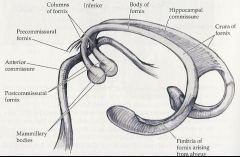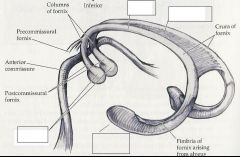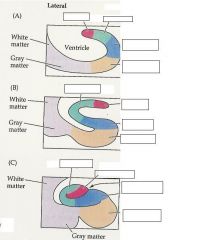![]()
![]()
![]()
Use LEFT and RIGHT arrow keys to navigate between flashcards;
Use UP and DOWN arrow keys to flip the card;
H to show hint;
A reads text to speech;
49 Cards in this Set
- Front
- Back
- 3rd side (hint)
|
If I am doing long division in my head, what type of "memory" am I using?
|
Working memory (Specifically, "active" working memory)
|
WM involves holding a particular concept briefly in awareness while a mental operation is performed.
|
|
|
If I am doing long division in my head, I am relying especially on the ___________ lobe, specifically the ____________ region.
|
frontal lobe (better: "frontal network"), especially the DORSOLATERAL PREFRONTAL region, mainly the LEFT (language-based) side.
|
Working memory (especially "active" working memory) is primarily an *executive* function and not a declarative memory function.
|
|
|
What kind of working memory is involved in doing long division without paper (in your head): Active or Passive?
|
Active ("mental blackboard" memory).
|
Passive working memory involves tasks like repeating digits forward. When you repeat them backwards, that's "active" working memory.
|
|
|
True or False: Unlike declarative memory loss, implicit memory usually is not significantly impaired by specific lesion.
|
True (B 782). Remember that implicit memory (skills, habits, conditioning) is very robust against any form of injury and may involve many different memory structures.
|
H.M. was able to learn certain tasks that did not require conscious recall. Also training implicit memory (use of habits) is the basis of much cognitive rehabilitation work with elderly and brain-damaged individuals.
|
|
|
Learning of skill and habits most likely involves plasticity (encoding) in three main areas--name them.
|
1) Basal ganglia
2) Cerebellum 3) Premotor area. (B782). Please refer to the HINT card also!! |
Recall that the basal ganglia are called a "procedural learning unit", and that the cerebellum is functionally very similar. The premotor area (especially supplementary motor strip) is involved in executing skilled actions. FYI (not for testing): The premotor area may simply process (rather than store) motor programs "sent" to it from Gerstmann's area--the area involved in dyspraxia (inability to mimic cutting with scissors).
|
|
|
A landmark case of amnesia, H.M. underwent surgery in what brain
region in an attempt to control epileptic seizures? |
bilateral (right and left) medial temporal lobes. Bilateral "hippocampi" is also acceptable. (B: 780)
|
H.M still participates in memory related research today. His seizures
improved and he has intact memories from childhood and up until a couple of years before the surgery. His personality and general intelligence remains similar to pre-surgery status, but he is no longer able to convert short term memories into long term memories. |
|
|
What structures does "medial temporal lobe" usually refer to? Name the two most important ones.
|
"hippocampus" (or hippocampal formation) and the parahippocampal gyrus.
|
The hippocampal formation and parahippocampal gyrus are continuous with each other, with the hippocampus at the forward "bulb" end and the parahippocampal gyrus just before that.
|
|
|
The hippocampal formation and parahippocampual formation are connected with each other as a continuous unit. What structure connects with the parahippocampal gyrus, ARCHing over the ventricles and attaching to the mammilary bodies?
|
fornix. (Means "arch").
|
See the illustration in Blumenfeld ("Limbic System" chapter).
|
|
|
Olfaction, declarative memory, emotions/drive, and homeostasis, are all primary functions of what brain system?
|
The limbic system. (B: 816)
|
Recall the HOME mnemonic.
|
|
|
Olfaction is part of the __________ system of the brain, which also includes declarative memory and other functions.
|
The limbic system.
|
Recall the HOME mnemonic.
|
|
|
True or False: Implicit memory is usually associated with the limbic system.
|
False. *Declarative* memory is associated with the limibic system (Circuit of Papez).
|
Implicit memory tends to be associated with a wide variety of brain structures, especially basal ganglia, cerebellum, and premotor cortex.
|
|
|
The Circuit of Papez is an important part of the ________ system of the brain, and is primarily associated with __________ (a cognitive function).
|
limbic system, primarily involved with (declarative) memory.
|
|
|
|
What type of memory is mediated by the Circuit of Papez?
|
Declarative memory.
|
|
|
|
Multiple Choice: When you store the definition of "dysdiadichokinesis" or what you had for breakfast, you are primarily engaging what brain structures (choose the BEST single answer):
(1) basal ganglia and dorsolateral prefrontal area, (2) left parietal angular gyrus and primary auditory areas, (3) Circuit of Papez |
Circuit of Papez. Please see the HINT card.
|
The basal ganglia and prefrontal cortex are strongly involved in memory RETRIEVAL, not memory encoding (memorizing "dysdiadichokinesis"). The angular gyrus is not part of the declarative memory system
|
|
|
The dendate gyrus, subiculum, and hippocamus are collectively called the ____________ _________.
|
Hippocampal formation.
|
|
|
|
Although the medial temporal lobe system is the primary area involved in memory encoding, the basal forebrain (flat bottom side of brain) is also involved. What is its general role?
|
Provides cholinergic input (acetylcholine) to the limbic memory system, providing "modulation" and "activation". The exact function is not well understood. Please see the HINT card for important information.
|
The basal forebrain is one of the first structures damaged in Alzheimer's (along with medial temporal lobe). Current medications try to replace the lost acetylcholine which is provided by the forebrain. For example, "aricept".
|
|
|
What neurotransmitter is involved in "cholinergic" neurons (e.g., basal forebrain).
|
acetylcholine.
|
|
|
|
What neurotransmitter is usually depleted by damage to the basal forebrain caused by Alzheimer's
|
acetylcholine.
|
|
|
|
The primary INPUT to the hippocampal formation arrives from the e____________ cortex, which transmits information from association cortex.
|
entorhinal cortex (B: 777)
|
Entorhinal cortex as a whole, therefore, receives highly-processed input from every sensory modality, as well as input relating to ongoing cognitive processes.
|
|
|
The primary output from the medial temporal lobe is via the f________ as well as the cingulum (internal "wiring" of the cingulate)
|
fornix.
|
|
|
|
Name two diseases (or conditions) which cause major damage to the hippocampal formation.
|
Alzheimer's Disease and anoxia (lack of oxygen). Severe head trauma can also cause damage.
|
The hippocampus is perhaps the most sensitive part of the brain to oxygen depreviation and one of the first areas damaged. Professional mountain climbers who climb at high altitutdes without oxygen tanks have been found to have memory damage due to this reason.
|
|
|
Professional mountain climbers frequently have mild memory impairment. What structure is primarily damaged, and what kind of memory (encoding, storage, recall) is affected?
|
Hippocamus. (Medial temporal lobe, hippocampal formation are also correct). Primarily affects encoding.
|
Recall that the hippocampus is EXQUISITELY sensitive to oxygen deprivation.
|
|
|
If you have a heart-bypass operation and there is a brief interruption in the oxygen supply to the brain, what brain structure is one of the most likely to be affected?
|
Hippocampus. See HINT card.
|
Factoid: In addition to hippocampus, areas of blood circulation in the brain which are furthest from the main arteries (so called "watershed areas) are also very vulnerable to damage. Mild aphasia may result, among other things.
|
|
|
Storage of declarative memory is primarily in the cerebral _______________.
|
Cortex (or "association areas").
|
Storage is usually in the association areas closest to where original processing occured. For example, auditory information may be near the temporal lobes. Such information is not usually "modality specific"--it involves a blending of different sensory information, such as your memory of an object (includes color, shape, weight, location, etc).
|
|
|
Your memory of a particular object (including color, shape, weight, location, etc), is likely to be stored in what kind of cerebral cortex: 1) primary sensory cortex, 2) heteromodal association cortext, 3) isocortex, or 4) archeocortex?
|
Heteromodal association cortex.
|
Recall that association areas consist of a "blended", highly processed mixture of sensory information (touch, vision, hearing, etc.)
|
|
|
The word "fornix" means _______ in latin, which is appropriate because it __________ over the top of the ventricles (in the middle).
|
"arch". It "arches" over the ventricles.
|
|
|
|
Name three "C"-shaped structures located near the lateral ventricles.
|
Fornix, Corpus Callosum, and Caudate Nucleus. (B:778).
|
"C"-shapes tend to be associated with structures near the ventricles.
|
|
|
The Fornix, Corpus Callosum, and Caudate all have a "___"-shape, because they all curve around or arch over the top of the _______________.
|
C-shape. Curve around and over the ventricles.
|
Examine the brain model which is available in class.
|
|
|
Name the major output pathway of the hippocampal formation.
|
fornix (B778).
|
It connects the medial temporal lobe (hippocampus) to the mammilarry bodies.
|
|
|
True or False: The cingulum is the most prominent white matter pathway underlying the Cingulate Gyrus.
|
True. (B779).
|
|
|
|
Global cerebral anoxia, such as caused by cardiac arrest, is characterised by marked damage (loss of pyramidal cells) especially in the ___________________.
|
hippocampus.
|
The hippocampus is one of the most sensitive structures in the entire brain--both to anxoxia and to any form of trauma.
|
|
|
Wernicke-Korsakov patients may have some deficits in ADDITION to memory loss. Name two such cognitive impairments and what structure is damaged (in addition to thalamus and mamillary bodies).
|
Possible answers include the following, due to damage in the frontal-network:
1) Judgment 2) Impulse control 3) Initiative 4) Sequencing 5) Confabulation (B:785) |
Recall that these are all associated with frontal-network functioning. (e.g., the mnemonic "RIO" or "ORDR")
|
|
|
Why do we refer to "frontal NETWORK" damage rather than "frontal LOBE" damage?
|
Because the frontal lobe is tightly linked to subcortical strucures, especially the basal ganglia. So they tend to operate as a unit. Thus, it may be impossible to separate frontal lobe function from basal ganglia function, for example.
|
|
|
|
Confabulation in Wernike-Korsakov patients is thought to be a result of _____________________ (name of a brain structure) dysfunction.
|
Frontal network dysfunction.
|
Due to disinhibition and loss of self-monitoring capabilities.
|
|
|
What is the primary cause of Wernicke-Korsakov syndrome? (Not the brain structure but rather the event/agent which damages the brain).
|
Thiamine (vitamine B1) deficiency caused by severe alcohol abuse.
|
Alcohol tends to block the uptake of thiamine. As a result the thalamus and, in some cases, mammilary bodies are damaged. Both are part of the Circuit of Papez
|
|
|
What is a common cause of permanent memory loss due to damage in the *anterior* (front) medial temporal lobes and the basal orbitofrontal cortex?
|
Cerebral contusions (bruising), such as caused by car accidents. (B:784)
|
Visualize what the front part of the temporal lobe looks like. It "points" forward towards the forehead, and therefore is very vulnerable to car crash, for example. The orbitofrontal cortex is vulnerable for a slightly different reason, not yet discussed--the bony "shelf" (just over the eyes) underneath the orbitofrontal cortex has many sharp edges, which tend to shred orbitofronal cortex.
|
|
|
True or False: Patients with Wernicke-Korsakoff syndrome tend to have good to excellent awareness of their memory deficit.
|
False. (B: 785)
|
They tend to lack awareness of their memory deficit. They may confabulate, providing spurious answers to questions rather than saying they do not remember.
|
|
|
A patient comes to you with complaints of severe memory loss, as well as lack of initiative and poor ability to sequence. His wife states that he "makes up stories", has terrible judgment, and "drinks way to much"--all of which the client strongly denies. What neurological disorder might you suspect as an etiology/diagnosis?
|
Wernicke-Korsakov syndrome.
|
The patient exhibits the most important feature of Wernicke-Korsakov syndrome (severe memory problems) plus many associated features. And he has an apparent history of alcoholism.
|
|
|
True or False: In patients with reversible causes of amnesia, the period of retrograde amnesia often gradually shrinks forward, so that older memories are recovered before more recent ones.
|
True.
|
|
|
|
A patient presents with a memory loss which involves loss of RECENT memories but relatively preserved OLDER memories. Do you think this is primarily caused by an ENCODING or a RETRIEVAL deficit.
|
Encoding, because formation of new memories is prevented. (By contrast, retrieval deficits result in difficulty placing older events in a chronological order).
|
We will be discussing this in class.
|
|
|
A patient states that he can't remember what he did last Christmas, the people who attended his birthday party 6 months ago, or when he first started on his blood pressure medication. However, he has no problem with recent events during the last several days. Is this more likely an ENCODING or a RETRIEVAL deficit?
|
Retrieval. (By contrast, encoding deficits involve forming new memories of RECENT events)
|
This has not been discussed in class, but should be self-evident.
|
|
|
"Source" memory involves placing a memory in its temporal and spatial _________.
|
Context. This means you can remember the specific time, place, and circumstances of an event.
|
The abiltiy to remember a memory's context (source memory) is involved in "episodic" memory--memory for events. As you recall, episodic memory is a type of declarative memory. The context of an event tends to be especially impaired in retrieval deficits, such as caused by vascular dementia or basal ganglia disorder.
|
|
|
Multiple Choice: Working memory is a type of (chose one):
1) "declarative" (explicit) memory 2) "nonclarative" (implicit) memory 3) executive functioning 4) none of the above |
Executive functioning. It's specifically associated with the DOROSLATERAL region of the frontal lobe.
|
Working memory (especially active working memory) is one of the oldest, best researched aspects of executive functioning.
|
|
|
What two measures could you use to assess "active working memory", and what part of the brain is this function associated with? (Pardon the clumsy sentence structure).
|
WAIS-III "digits backward", "number-letter sequencing" subtests). It's associated with DORSOLATERAL PREFRONTAL CORTEX, primarily on the LEFT (language dominant) hemisphere.
|
|
|
|
Some inputs reach the hippocampus from the contralateral hippocampus (opposite side of brain) via the h______________ c______________.
|

hippocampal commissure. See HINT for additional important information.
|
This may help explain why removing just one hippocampus does not result in severe memory
|
|

Please label the parts (empty boxes).
|

One label is not on this diagram (bottom). This is the hippocampus (or "hippocampal formation").
|
|
|
|
The term "hippocampus" is often used as a synonym for the h__________ f___________. This is can be confusing!
|
hippocampal formation (subiculum, hippocampus, dentate gyrus).
|
|
|
|
The "entorhinal cortex" is actually the covering (cortex) around the p____________________ gyrus
|
parahippocampal gyrus
|
This is not very important--just wanted to clarify a possible confusion regarding the relationship between the two areas.
|
|

Please label the parts (empty boxes).
|

We will do clay modeling in class to get a clearer idea of how these structures fit in the brain.
|
|

